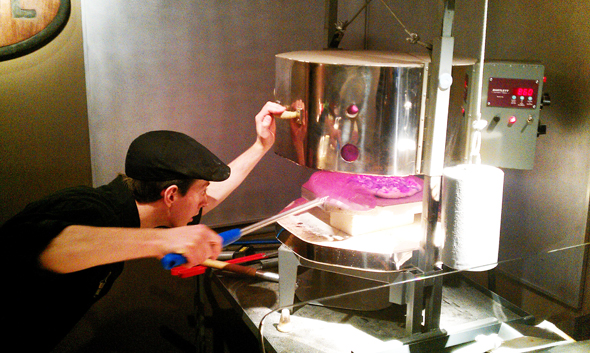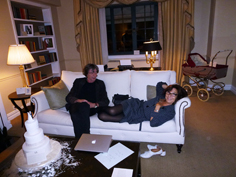Fiction & Non-Fiction (People who live in glass house build another house in brick to sleep in.)
New York has been delivering of late. The service laden city has been providing narrative(s)—the best of which hover over fiction, but in fact are real. A well occupied truism, that is in fact, true. People can be classified in this manner as well. Practitioners or objects themselves that maintain a position along this precipice may suspend our ability to engage with them. When works appear to be too universal or populist we can be dismissive of their presence. Until…
The moment occurs when we are able to see them again, or see them for the first time.
This week in the New York City region, the following re- or appeared: pizza, ice cream and bananas, Mark Hughes, Sophie Calle, smoking in bed, Andy Warhol, Philip Johnson, Charles Renfro as Philip Johnson, Freud, Alexander Gorlin, a smoking bed, brick and glass as houses and as materials. All of which can be meta-tagged as sustainable entries.
The week of October 17, 2011 began with a ubiquitous food item that inspired this week’s entry and is akin to Bill Cunningham and his “On the Street” column and how he is able to see what has currency simply because the items keep showing up in his photographs.
At 68 Jay Street in Dumbo, an interstitial Neopolitan pizzeria, Wild Rise and its maker appear on Sunday, Monday and Tuesday evenings. It all begins with a wild yeast starter from Naples that is imported to make the pies rise. They are then cooked at 900 degrees in a retrofitted electric kiln that can open and close on a pulley system. Not being a triticum eater, Michael Isabell of Eyespy Films tasted the offerings and exclaimed how outstanding the crust actually is. Wild gets a rise.
Following pizza, there was a movement to SoHo House later that weekend with Mark Hughes who was hosting a group from Sydney, Australia. They openly discussed taxation, the Australian economy and the new environmental policies and carbon tax. Australia seems light years ahead of the US in terms of policy in general, and specifically on the environment and their economy. As evolved as Australia actually is, there is even partisan consensus. It makes the US appear as a Möbius strip that folds back to the ecology movement initiated during the Carter era that never fully evolved, and where the right always meets up with the left. At the very least, it did create the Environmental Protection Agency (EPA) the Federal government’s regulatory agency for the environment, but we all know how hogtiedthe EPA has been during its history.
Sophie Calle was my offering for dessert. She was in NYC from Paris to realize her work, Room from 10.13—10.16.11 as a part of “Crossing the Line” that was organized by the French Institute Alliance Française (FIAF). Mr. Hughes wanted to escort his guests who will be living part-time in NYC uptown and they were willing to stop with us at the Lowell Hotel to check if Sophie Calle was a work of fiction or non-fiction.
It was non-fiction.
We exited the elevator on the third floor of the Lowell Hotel, an elegant boutique hotel comprised of suites on 63rd Street between Park and Madison on the south side of the street and opened the door. Sophie Calle was curled like a cat on the sofa with her friend Yves and they had just ordered two glasses of white burgundy from room service. We all conversed and then viewed the artifacts displayed throughout the suite. This included a narrative about a mattress that was Sophie’s bed from childhood that a boarder had slept in and set fire to it.
In Philip Johnson’s Glass House on his estate in New Canaan, Connecticut that is now a part of the National Trust for Historic Preservation the bed and fireplace are both visible from the exterior on the site, but also from Ponus Ridge Road. The preservation and activation of these sites is paramount to maintaining a critical and historical model that enhances the cultural canon.
A myth has been perpetuated about the trees that closet the structure. On October 20, 2011 at 5:30 pm, a conversation as tour was conducted by the architect Charles Renfro of Diller, Scofidio + Renfro who invited Alexander Golin of Alexander Golin and Associates and myself to join in the conversation. Having done extensive research on Mies Van der Rohe’s Farnsworth House (the Glass House) with a great deal of time spent at its Plano, Illinois location as well as in the Mies Van der Rohe archives at MOMA, the question lingered in my mind of how Philip Johnson’s Glass House would compare to Mies’s.
Being at the site, it was extraordinary to experience the rest of the buildings on the property—architectural follies that clearly distinguish Johnson from Mies. In this digital age, removing elements from an image is a common practice. Similar to how Bill Cunningham leaves his images as is—un-touched, the visual or physical understanding that Johnson’s Glass House is not only the Glass House, but also its counterpoint, the Brick House. Architectural history has photo-shopped out the Brick House. Visiting the site in person alters the narrative surrounding glass as a material, but also makes it possible to see Philip Johnson’s Glass House for the first time for what it actually is, a house that is actually comprised of two structures, one in brick and one in glass. At 798-856 Ponus Ridge Road, New Canaan, Connecticut the Brick House is where most of the sleeping took place, or not.
If the Brick House is non-fiction, the Glass House is fiction and the pool is literally the ‘martini glass’ as the round form that is mirrored and penetrates the roofline of the Glass House as a column. As Alexander Gorlin noted in ending, it would be a Greek plan, not Roman.









